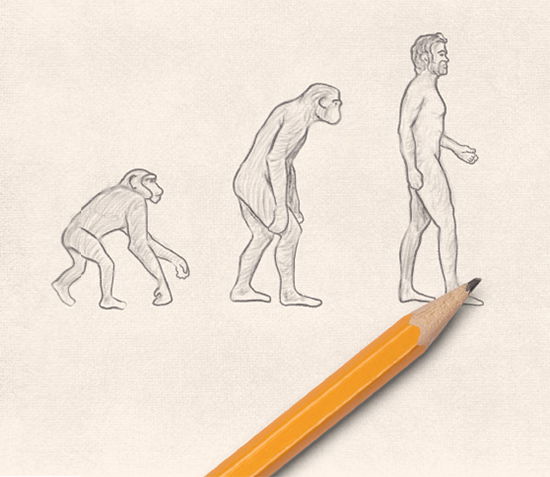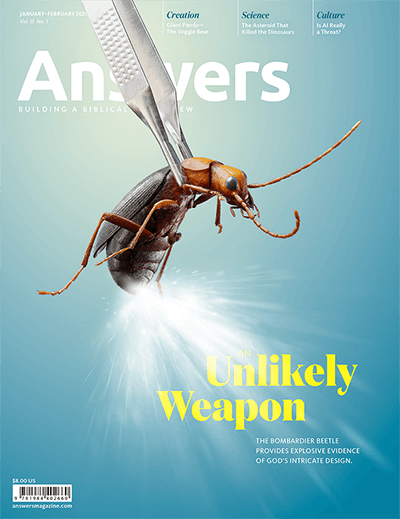
Teaching Evolution to the Next Generation
Rather than being taught platitudes and dismissive mockery, young Christians need thorough training in evolutionary beliefs.
As a science teacher in Christian schools, I’ve noticed a predictable progression when students begin studying evolution. They start with a mocking attitude that “evolution is stupid.” But when I present the details accurately, a bewildered hush falls over the class. Quizzical looks are followed by raised hands and vociferous objections. They sound betrayed.
Finally, as they discover biblical answers from the creation perspective, light bulbs turn on, and their perplexity is replaced with relief. They then are able to communicate their thoughts about origins more coherently and confidently.
We fall short if we tell Christian youth that the study of origins doesn’t matter or that it’s a side issue. We underestimate evolution’s threat to their faith. I’ve spoken to many adults who left the faith, asking, “Why didn’t they tell me this?”
God’s Word exhorts us to be prepared to defend our faith (1 Peter 3:15). The “just believe” mentality does not prepare us for life in a hostile, secular world. Evolutionists have their story straight, and we must not underestimate its power to entice vulnerable young people. At the very least, ignorance makes us less effective in engaging the lost with the gospel.
We get frustrated when evolutionists misrepresent the creationist position, but they feel the same way about us. Why should they listen if we can’t even accurately describe their position? Rather than teach young Christians platitudes and dismissive mockery, we need to teach them how to defend origins from a biblical standpoint. That includes introducing them to unbiblical ideas and how nonbelievers arrive at those ideas.
Here are the four most helpful principles I’ve learned for effectively teaching evolution. They are useful in any educational environment—home, church, or school.

Art by Chris Neville
But Won’t They Get Hurt?
Before we examine the “how to” of teaching evolution to young people, we need to address one common concern. Some people object to treating our precious, vulnerable young ones like soldiers going to war.
But that is exactly where they’re headed when they leave home, and the skirmishes will begin even while they are at home. Our world has become extremely secular, but we must remember that, in many senses, things have always been this way. We know from 1 Peter 5:8 that the devil prowls about, and he wants to devour our kids, the most vulnerable sheep in the flock.
God instituted two safe havens—the home and the church (and by extension, Christian schools)—where inexperienced recruits can test and refine their skills under close supervision by people who love them and God’s Word. One day, children from Christian homes will face a real enemy who wants to destroy them, whether by blunt force or by deceit. Proper training requires lots of time and hands-on experience.
Questioning the faith that others have taught us is often necessary for making faith our own. If a believer never asks questions, this might be a sign that the person’s faith is borrowed and has no depth.
But what if in the process of being exposed to evolutionary ideas they start questioning their faith? Actually, facing challenges to our faith is a healthy thing (1 Peter 1:6–7). Questioning the faith that others have taught us is often necessary for making faith our own. If a believer never asks questions, this may be a sign that the person’s faith is borrowed and has no depth, which is reason for concern.
The idea that we shouldn’t question our faith stems from misconceptions of biblical faith. Biblical faith is not blind belief. Faith rests on fact and works together with reason. (See Luke 7:18–23; 1 Corinthians 15:1–20; Hebrews 11:19.) Christian faith is thoroughly and actively intellectual.
We have the privilege and responsibility of teaching and shepherding the young ones under our care (Deuteronomy 6:7; Luke 12:42). It is a tough job, but we must prepare them well for the arduous trials of mature Christian life.
And there’s plenty of good news to encourage us. Christians have more detailed answers to tough questions than ever before. Not only that, but the Bible has always provided the best answers to the major questions that believers and unbelievers of every generation have asked. We also have every advantage in the world: We know that attacks are coming, we know which attacks are coming, and we have a chance to anticipate the attacks and to prepare defensive and offensive strategies. Most importantly, we have the infinite power of God’s Word and God’s Spirit.
Training Principle 1: Know What the Other Side Says
Now we can turn to the four lessons I’ve learned about teaching evolution to young people. First, they need to know what the enemy is saying.
I’ve met some Christians who don’t see the value in understanding non-Christian perspectives. They often repeat the saying that the best way to spot counterfeit money is to know the real thing. If they know the Bible well, they will know what is wrong with unbiblical beliefs like evolution. While that philosophy is helpful, it has its limits. It’s important that Christians understand evolution well. That begins with us, as teachers and parents. In fact, we adults should strive to understand evolution better than evolutionists.
Knowing the specifics allows us to talk more intelligently and effectively with unbelievers. We can adapt our discussion to the audience’s beliefs and vocabulary. Consider the challenge of sharing the gospel with a Mormon. We can’t just say to “believe in Jesus” because they have so many wrong ideas about Jesus and faith. But we won’t know that unless we first study Mormonism.
The same is true of evolution. We shouldn’t just tell people who believe in evolution that animals “aren’t evolving” because evolutionists use the term evolution in many different ways. It can mean minor genetic mutations, which creationists also acknowledge. So we need to be able to define terms in ways both sides can understand.
Example: Avoid Straw Man Arguments Such as “Apes Aren’t Evolving”
There are many other benefits to knowing evolution well. Christians who explore evolution in the words of its followers are less likely to make foolish claims. For example, have you ever heard (or perhaps said yourself), “Why are there still monkeys if humans evolved from them?”
That’s a straw man argument, but you might not know it unless you had worked directly with evolutionary materials. I like to help students navigate websites that offer an interactive evolutionary tree of life. As students learn to interpret the diagrams on these websites, they also learn how evolutionists think about the world.
Training Principle 2: Put Them in the Hot Seat
If it’s true that this is a war, then it makes sense to give young people a taste of what they’ll face. Preparing people for war is not nice business. You can’t coddle them; you have to simulate the real thing.
So we should challenge them with some of evolution’s best “evidences,” both in favor of evolution and against creation. Confronting people with discrepancies (ideas that don’t fit their worldview) rocks them off their positions of self confidence and makes clear their need for humility and dependence on the Lord. They have work to do. The traditional evidences that textbooks push, such as homology, fossil series, and embryology, are a good place to start.
A good strategy is to use questions you have wrestled with. If the answers are burned into your heart, you’ll be better prepared to guide young people through the question.
We want them to ask questions. If they aren’t asking, we need to raise questions for them. Using tough questions to create dissonance in their thinking is a powerful way to ignite questions and a desire for answers. After all, people don’t seek answers to questions they aren’t asking.
When parents hear my suggestion, they sometimes express fear that the young Christian might begin to believe the evolutionary ideas. However, going through this process in advance, under the care of a more mature Christian, is far better than to being exposed to it for the first time in a hostile environment. Which will be better to prepare soldiers: pamper them until their first battle, or toughen them by rigorous training and battle simulations?
Example: Look for What’s Missing in the “Best Evidences for Evolution”
I have a list of 10 convincing evidences for evolution that capture students’ attention. These are things evolutionists often bring up, in order of increasing difficulty. Yet creationists have very good answers for them, so young people will grow in confidence as they try to find answers.
- Vertebrates have similar (homologous) bone structure.
- The appendix is a vestigial organ.
- Human and ape DNA are very similar.
- The similarity of reptile scales and bird feathers is evidence that dinosaurs turned into birds.
- Living things can be arranged into nested hierarchies (degrees of similarity).
- Placental mammals have a yolk sac.
- The human eye is a bad design.
- Bacteria has adapted to a new food source: citrate.
- Two ape chromosomes allegedly fused to produce human chromosome 2.
- The ability to produce vitamin C in primates is an example of pseudogenes, or shared mistakes, as evidence for common ancestry.
In each case, I start by presenting the problem and then letting it sink in that this does not line up with Scripture. Students do not immediately see a problem, and I do not give them the answers right away. Instead, I have them evaluate an article or video by an evolutionist on this topic. Then I ask them to compare the evolutionist’s claims with a creationist’s take on it. A simple internet search at answersingenesis.org will bring up plenty of solid answers on all 10 of these evidences. The goal is for them to be able to find answers on their own later in life.
Take the argument that the human eye is a bad design, for example. Any quick internet search of “human eye” and “bad design” will bring up arguments mocking the fact that the blood vessels are in the front and get in the way of eyesight. Evolutionists claim the Creator got it backwards.
I let them wrestle with this question, and then I hand them a creationist explanation. All the cells in the eye need regular blood flow. So the eye has ways to maintain the clarity of the image, including cells that act as fiber optic cables that carry the signals through the retina to the back of the eye. What starts as an intimidating challenge to creation ends up making God’s handiwork look more impressive. This exercise reinforces that, whenever we encounter an evolutionary argument, students should assume there is more to the story (as there always is).
Training Principle 3: Develop the Skill of Discernment; Don’t Just Memorize Facts
It’s not enough to read evolutionists’ “best evidences” and merely memorize answers. Young people need to develop the skill of discernment that they can apply to any new situation.
Developing discernment is incredibly difficult. The enemy is good at cleverly intertwining truth and falsehood, so it is hard to tell the difference. Hebrews 5:14 tells us that mature Christians need to be trained, through practice, to discern between good and evil. Being able to untangle these knots is crucial.
All of this requires practice. They (not you) need to be doing the mental work. Requiring them to work out the answers is far better than spoon-feeding them. They should be the ones primarily asking questions and evaluating their own beliefs.
This doesn’t mean we’re just throwing them out there to fend for themselves in a sink-or-swim fashion. Our job is to point them toward resources, to challenge their weak responses, and to raise the right questions when they miss them.
Key Concept: Discern Historical vs. Observational Science
I’ve found that the number one discernment concept to teach is the difference between observational and historical science. Even the common use of the word evolution confuses these two things. There is a huge difference between the process of living things changing and adapting to their environments (observational science) and the idea that all living things are related by common ancestry (historical science). Yet both of these meanings are often dumped together under the same category of “evolution” without caveat.
Students need to learn to constantly ask themselves this question every time they read about evolution: Is the author referring to observed changes in animals living in the present or a hypothesis of unobserved vast changes in the past?
It is very important that Christians understand how living things change over time and keep these facts separate from origins ideas. God created animals “according to their kind,” with genetic variability to adjust to changing environments and fill the earth. Natural selection is a real process, mutations can be beneficial in certain contexts, and new species really do arise over several generations. God has lovingly provided many ways for his creatures to survive and fill a fallen earth—including built-in mechanisms for adaptation. We can observe and experiment on these processes in the real world. But this limited variability happens within the original created “kinds.” Cats are still cats, and finches are still finches.
These are not concessions but exciting science that confirms and strengthens the biblical view of biology. In fact, I’ve found that students really enjoy learning about how living things adapt and change, and that studying these processes leads to good questions about the Bible. Rather than instill denial, we want to cultivate a sense of exploration and fearless curiosity.
The best way I have found to develop the skill of discernment is to examine secular educational resources directly. The Howard Hughes Medical Institute (HHMI), for instance, has many educational resources from an evolutionary point of view. Their videos and activities on anole lizard evolution, rock pocket mouse evolution, and human lactose tolerance evolution can act as great training exercises for how to pick apart truth from error. Questions to ask during these exercises include, “Which parts of the video are factual, observational science? Which parts are interpretations of facts?”
Creation resources should be the meat and potatoes of a Christian’s science diet. But there are real benefits to sprinkling lessons with evolutionary resources. Such an approach has an inoculating effect against the most convincing and intimidating claims.
Training Principle 4: Turn It Around—Appeal to the Creator and His Word
Ultimately, helping Christians keep their faith and effectively engage the world involves showing them that the Bible has the answers. It furnishes everything they need (1 Timothy 3:16–17). This confidence helps them face any idea that may come their way. The more specific ways they see the Bible’s power to meet their needs, the more rooted their faith will become.
Martial artists and wrestlers know how to use their opponents’ momentum against them. Likewise, it is not necessary for us to come up with completely new, detailed evidence to support creation against every complicated new claim of evolution. Instead, the goal is to emphasize that biblical creation can better account for whatever we are looking at.
Often, a perspective we have already learned will apply to many different cases. One such perspective repeatedly stands out: a single Designer provides a more satisfying explanation for similarities in living things.
Example: Common Ancestor or Common Designer?
Consider how creationists respond to possibly the most famous evidence for evolution, homology. This is the claim that living things are so similar that they must have come from a common ancestor. But these similarities also make sense if a single Creator made all living things. Young people quickly grasp the point if you show them multiple buildings designed by the same architect or play multiple songs written by the same composer (just listen to film scores by John Williams).

Art by Chris Neville
Let’s Do This
More important than refuting error, however, is our charge to build young people’s confidence in God’s unchanging and undefeated Word rather than humanity’s waffling and failed ideas.
Ultimately, it is not up to us to decide who will embrace a life of faith and obedience to Christ. But God has called us to do our part to prepare a generation that will persevere and brightly share his light with the world. He wants us to be intentional in our training. That includes teaching evolution.
More important than refuting error, however, is our charge to build young people’s confidence in God’s unchanging and undefeated Word rather than humanity’s waffling and failed ideas. They also need to put God’s Word to the test, watching it work in their own lives as well as in the lives of others.
Whether you’re a parent, grandparent, schoolteacher, or youth worker in church, you have a difficult task ahead. “The days are evil,” Paul warns us (Ephesians 5:16). Yet God’s truth, power, and faithfulness are unchanging. The Holy Spirit will give us the grace we need so that, as we work to train the next generation, we can confidently commit them to Christ’s care.
Pitfalls Students Should Avoid
Students frequently embrace these common misconceptions about evolution.
“New Species Cannot Form”
Christians often confuse species (a modern scientific term for closely related organisms that can interbreed) with kinds (a biblical term for different, unrelated groups). In reality, God placed a large amount of variety and adaptability within each created kind so it could diversify and fill the earth.
“Natural Selection Is Equivalent to Evolution”
We can observe natural selection in the present, including its role in producing variations within God’s created kinds. But this is not the same as the evolution of one kind of animal into another kind. That would require great amounts of new genetic information.
“We Observe Microevolution but Not Macroevolution”
I teach my students to avoid these terms because they create the impression that little changes can add up over time to produce completely new kinds of living things. We observe minor variations within existing kinds (a better term), but we do not observe the evolution of completely new kinds of creatures.
“There Are No Transitional Fossils”
It is true that variations appear among the fossils of God’s created kinds. Yet evolutionists interpret such variations as evidence of one kind of creature changing into another kind. It is important to define terms like transitional when interacting with evolutionary materials.
Answers Magazine
January–February 2020
Unlikely Weapon: The bombardier beetle provides explosive evidence of God’s intricate design.
Browse Issue SubscribeRecommended Resources

Answers in Genesis is an apologetics ministry, dedicated to helping Christians defend their faith and proclaim the good news of Jesus Christ.
- Customer Service 800.778.3390
- © 2024 Answers in Genesis





